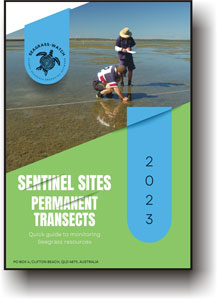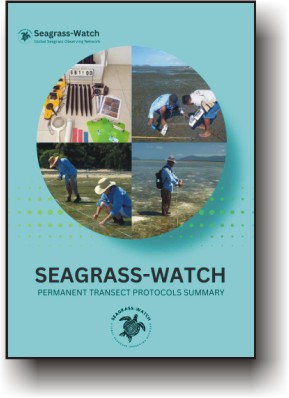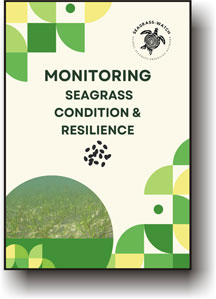Global monitoring
INTERTIDAL & SUBTIDAL
data collection
WHAT IS MONITORING?
Monitoring is the repeated observation of a system, usually to detect change. Environment monitoring programs provide coastal management agencies with data to make evidenced-based decisions and policy.
SEAGRASS MONITORING
Seagrass-Watch long-term monitoring started early August 1999. More than 26 countries participate in the program globally and seagrass monitoring is currently occurring at more than 335 sentinel sites and growing.
Each Seagrass monitoring event usually takes about two hours to complete, once you have become familiar with the methods.
When starting your seagrass monitoring, we recommend four monitoring events in the first year (every 3 months) to provide an understanding of seagrass seasonality.
How frequent your monitor your seagrass site, is at the discretion and capacity of participants.
For long-term seagrass monitoring, we recommend monitoring at least once a year, around the same time each year.
The recommendation for sampling replicates sites within a location is that sites be sampled no longer than a maximum of 2 weeks apart. Any longer would risk compromising the data.
SEAGRASS MONITORING DATES
All seagrass monitoring dates and times are provided by local monitoring groups. Seagrass-Watch HQ provides technical support and does not direct local on-ground activities.
SEAGRASS MONITORING STRATEGIES
Seagrass-Watch has several seagrass monitoring strategies depending on the type and location of seagrass meadows.
Methods and sampling designs will continue to be modified and improved and the approach described here is not intended as a standard suitable for all situations. We recognise that sampling designs are largely influenced by logistics, safety issues and resource limitations.
Priority should be placed on selecting appropriate parameters for monitoring, so that results and subsequent environmental assessments are ecologically meaningful.
Some examples of our monitoring designs include intertidal Permanent Transect site, intertidal fixed point site, subtidal fixed single transect, subtidal spots in defined area, depth transects across a meadow.
This section also covers how often to monitor, pre-monitoring preparation and safety issues to consider.
Below we describe the most popular method (Permanent Transects).
IF you do not think the method is suitable for your seagrass meadows (for example, the seagrass meadow is subtidal or not of a size able to contain a 50m by 50m site), alternative strategies are available in the Seagrass-Watch manual or contact Seagrass-Watch HQ for advice.
HOW TO MONITOR USING THE MOST POPULAR METHODOLOGY
PERMANENT TRANSECTS
The use of Permanent Transects ( aka transect-based seagrass monitoring) , is a strategy developed by Seagrass-Watch and is commonly used in representative inter tidal meadows larger than 50m x 50m (e.g. 5.5 hectares).
A sentinel site (Permanent Transect sites) is 50m x 50m area within a homogeneous section of meadow. At each site, three parallel 50m transects (each 25m apart) are established. We advocate, “permanently” marking the site using a GPS to record points at the start and end of each transect. If you must physically mark the site, generally only the middle transect is permanently pegged/marked.
The location of sites is recorded by GPS. The seagrass along each transect are sampled by visual observation. At each transect, eleven quadrats are sampled (1 quadrat every 5m), every sampling event. All quadrats sampled are photographed to ensure standardisation/calibration of observers and to provide a permanent record.
Lay out and peg down the three 50 transects parallel to each other, 25m apart and orientated perpendicular to shore (heading out to sea or deeper water). Within each of the quadrats placed for sampling, complete the following steps (below):
About Permanent Transects/transect-based seagrass monitoring
(demonstration Video)
Please note: This video is only intended for demonstration purposes. For more detailed information and consultation, please contact Seagrass-Watch HQ
HOW TO MONITOR USING THE MOST POPULAR METHODOLOGY
- Step 1. Take a Photograph of the quadrat
- Step 2. Describe sediment composition
- Step 3. Describe other features and ID/count of macrofauna
- Step 4. Estimate seagrass percent cover
- Step 5. Estimate seagrass species composition
- Step 6. Measure canopy height (cm)
- Step 7. Estimate algae percent cover
- Step 8. Estimate epiphyte percent cover
- Step 9. Voucher specimen if required
- Step 10. Move to next quadrat
- Step 11. Completion of monitoring
- Photographs are taken at the every quadrat (0m-50m) along each transect.
- First place the photo quadrat labeller beside the quadrat with the correct code on it.
- Take the photograph from an angle as vertical as possible, which includes the entire quadrat frame, quadrat label and tape measure. Try to avoid having any shadows or patches of reflection off any water in the field of view. Tick the photo taken box on the datasheet for that quadrat. Please note: Camera should be set at the highest quality.
- To assess the sediment, dig your fingers into the top centimetre of the substrate and feel the texture.
- Describe the sediment, by noting the grain size in order of dominance (e.g., Sand, Fine sand, Fine sand/Mud).
- Please do not use descriptors like Sandymud, SandyMuddy, Muddysand etc
- Note and count any other features which may be of interest (eg. number of shellfish, sea cucumbers, sea urchins, evidence of turtle feeding), within the comments column.
- Count or estimate as best you can. Please do not use > or < symbols.
- If more than 50% of the quadrat is covered by water, measure and record the water depth in cm.
- Looking down on the quadrat from above, estimate the total percentage of the seabed (substrate) within the quadrat covered by seagrass. – use the percent cover photo standards as a guide.
- When estimating cover, estimate the footprint/shadow provided by the seagrass shoots
- Always use the percent cover photo standards (calibration sheets) as your guide
- Estimate cover as accurate as possible, e.g. 27%, 61%
- Identify the species of seagrass within the quadrat and determine the percent contribution of each species to the cover.
- When determining species composition for two or more species, always start with the least dominant.
- Use seagrass species identification keys provided.
- Use more than 1 feature to identify the species
- Total composition must equal 100%
- Measure canopy height of the dominant strap leaved species ignoring the tallest 20% of leaves.
- Measure from the sediment to the leaf tip of at least 3 mature leaf blades (strap leaved species).
- Write the 3 measures (cm) on the datasheet.
- Estimate % cover of algae in the quadrat.
- Algae are seaweeds that are not attached to seagrass but may cover or overlie the seagrass blades.
- Malcroalgae percentage cover is independent of seagrass cover, for example, you can have 100% seagrass and 100% algae (drift).
- Use “Algal percentage cover photo guide”.
- Epiphytes are algae attached to seagrass blades and often give the blade a furry appearance.
- First estimate how much of the blade surface is covered, and then how many of the blades in the quadat are covered (e.g., if 20% of the blades are each 50% covered by epiphytes, then quadrat epiphyte cover is 10%).
- Do not include epifauna with epiphytes. Epifauna are sessile animals attached to seagrass blades – please record % cover of epifauna in the comments or an unused/blank column – do not add to epiphyte cover.
- Use the epiphyte matrix to help you in the field. (DOWNLOAD: Epiphyte_matrix.pdf)
- Voucher specimens are only required if:
- establishing monitoring in a new region; a new seagrass species is present;
- or if you are unsure of the seagrass identification.
- Seagrass samples should be placed inside a labelled plastic bag with seawater and a waterproof label.
- Select a representative specimen of the species and ensure that you have all the plant part including the rhizomes and roots.
- Collect plants with fruits and flowers structures if possible.
- Voucher specimens are only required if:
- Repeat steps 1 to 8 for the remaining 32 quadrats
- Check data sheets are filled in fully.
- Ensure the full names of all observers (last name and first name), the date and site/quadrat details are clearly recorded on the datasheet.
- Also record the number of other observers assisting.
- Also record the GPS positions of the end of each transect.
- Remove equipment from site
- Remove all non-permanent pegs and roll up the tape measures. If the tape measures are covered in sand or mud, roll them back up in water.
- Wash & pack gear
- Rinse all tapes, pegs and quadrats with freshwater and let them dry.Review supplies for next quarterly sampling and request new materials
- Store gear for next quarterly sampling
- Press any voucher seagrass specimens if collected
- Submit your Data to Seagrass-Watch HQ
How to Seagrass-Watch
(demonstration Video)
Please note: This video is only intended for demonstration purposes. For more detailed information and consultation, please contact Seagrass-Watch HQ


